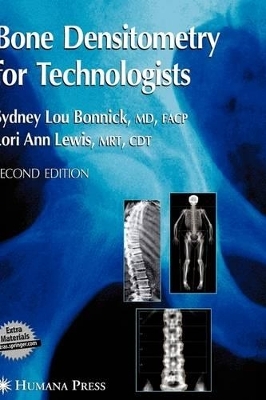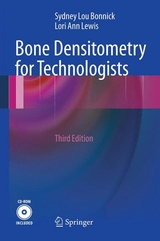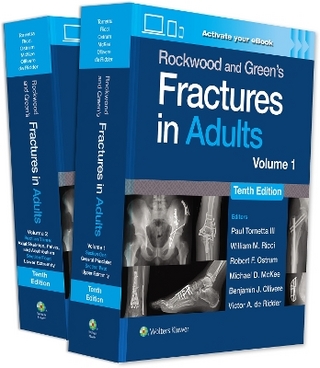
Bone Densitometry for Technologists
Humana Press Inc.
978-1-58829-670-2 (ISBN)
- Titel erscheint in neuer Auflage
- Artikel merken
Sydney Lou Bonnick, MD, FACP, and Lori Ann Lewis, MRT, CDT, have updated and expanded their highly praised Bone Densitometry for Technologists to reflect the latest standards and developments in the field. Here radiologic technologists, nurse practitioners, physician assistants, and dedicated densitometry technologists can find new guidelines for bone density testing, new therapies for osteoporosis, and new treatment guidelines for osteoporosis, as well as new chapters on pediatric densitometry, body composition assessments, and the use of skeletal morphometry in diagnosis and fracture risk prediction.
Chapter 1: An Introduction to Conventions in Densitometry Densitometry as a Quantitative Measurement Technique Accuracy and Precision The Skeleton in Densitometry Weight Bearing or Non-Weight Bearing Axial or Appendicular Central or Peripheral Cortical or Trabecular What Do the Machines Actually Measure? The Effect of Bone Size on Areal Densities Bone Mineral Apparent Density Calculating "Average" Spine Bone Densities Ultrasound Parameters The Densitometry Printout The Percentage Comparisons The Standard Score Comparisons The Age-Regression Graph The Standardized BMD The Utility of the sBMD The National Health and Nutrition Examination Survey (NHANES) III Database for the Proximal Femur Nomenclature Guidelines From the International Society for Clinical Densitometry References Chapter 2: Densitometry Techniques Plain Radiography in the Assessment of Bone Density Qualitative Morphometry Qualitative Spinal Morphometry The Singh Index Quantitative Morphometric Techniques Calcar Femorale Thickness Radiogrammetry The Radiologic Osteoporosis Score Radiographic Photodensitometry Radiographic Absorptiometry Photon Absorptiometry Techniques Single-Photon Absorptiometry Dual-Photon Absorptiometry Dual-Energy X-Ray Absorptiometry Peripheral DXA Single-Energy X-Ray Absorptiometry Quantitative Computed Tomography Peripheral QCT Quantitative Ultrasound Bone Densitometry References Chapter 3: Skeletal Anatomy in Densitometry The Spine in Densitometry Vertebral Anatomy Artifacts in PA or AP Spine Densitometry Vertebral Fractures Effect of Osteophytes on BMD Effect of Aortic Calcification on BMD Effect of Facet Sclerosis on BMD Effect of Vertebral Rotation on PA Lumbar Spine Bone Density Other Causes of Artifacts in PA and AP Lumbar Spine Studies The Spine in the Lateral Projection The Proximal Femur in Densitometry Proximal Femur Anatomy Effect of Rotation on BMD in the Proximal Femur Effect of Leg Dominance on BMD in the Proximal Femur Effect of Scoliosis, Osteoarthritis, Osteophytes, Surgery, and Fracture on BMD in the Proximal Femur The Forearm in Densitometry Nomenclature Effect of Arm Dominance on Forearm BMD Effect of Artifacts on BMD in the Forearm The Metacarpals, Phalanges, and Calcaneus References Chapter 4: FDA-Approved Densitometry Devices Computer-Enhanced Radiogrammetry Computer-Enhanced Radiographic Absorptiometry Central X-Ray Densitometers Peripheral X-Ray Densitometers Ultrasound Bone Densitometers Chapter 5: Computer Basics Types of Computers Desktops, Towers, Minitowers, and Laptops PCs and MACs Major Components of a Computer System Important Components Inside the Computer Housing Motherboard, Random Access Memory, and Slots Central Processing Units Hard Drives Internal Disk Drives Input Devices The Keyboard The Mouse The Trackball Output Devices Monitors Printers Computer Ports Keyboard and Mouse Ports Parallel Ports Serial Ports Universal Serial Bus Ports Power, Monitor, Modem, and Network Ports Types of Storage Media Magnetic Media Optical Storage Media Flash Memory Protecting the Data Computer Maintenance Chapter 6: The Importance of Precision The Concept of Precision Performing a Precision Study Short-Term Precision Studies Mathematical Procedures Used to Calculate Precision Long-Term Precision Studies Applying the Precision Value to Serial Measurements Determination of Least Significant Change Using the Least Significant Change to Determine the Timing of Repeat Measurements A Case in Point More Sophisticated Issues of Statistical Confidence for the Measured Change Determining the Level of Confidence for Any Change and Precision The Confidence Interval for the Change in BMD Between Two Measurements The Importance of Precision Which Skeletal Sites Should Be Used for Monitoring How Frequently Should Measurements Be Repeated? A Final Consideration References Chapter 7: Radiation Safety in X-Ray Densitometry Radiation Basics Radiation Quantities The Curie The Roentgen The Rad The Rem The Effective Dose Equivalent Harmful Effects of Ionizing Radiation Acute Lethal Radiation Syndromes Local Tissue Damage From Radiation Skin Ovaries and Testes Bone Marrow and Blood Late Effects of Ionizing Radiation Radiation Doses in Densitometry Radiation Protection Programs Protection of the Public Protection of the Patient Protection of the Technologist Time, Distance, and Shielding Personnel Monitoring Devices The Pregnant Technologist References Chapter 8: Quality Control Phantoms European Spine Phantom Bona Fide Spine Phantom Hologic Spine and Hip Phantoms Lunar Spine Phantom Using the Phantom to Create Control Tables and Charts Shewhart Rules and CUSUM Charts Shewhart Rules CUSUM Charts Automated Quality Control Procedures Replacing a Densitometer References Chapter 9: An Overview of Osteoporosis The Definition of Osteoporosis The 1991 and 1993 Consensus Development Conferences The 1994 World Health Organization Criteria for Diagnosis of Osteoporosis The 2000 National Institutes of Health Consensus Conference Definition of Osteoporosis Prevalence of Osteoporosis Consequences of Osteoporosis Risk Factors for Osteoporosis Attainment of Peak Bone Density Maintenance of Bone Density Guidelines for Bone Mass Measurements The National Osteoporosis Foundation Guidelines for Bone Mass Measurements Guidelines From Specialty Societies The 1997 Bone Mass Measurement Act Treatment Guidelines for Postmenopausal Osteoporosis NOF Guidelines Treatment Guidelines From AACE and NAMS Interventions in Osteoporosis Nonprescription Interventions Lifestyle Modifications Calcium, Vitamin D, and Exercise Prescription Interventions Estrogen Replacement The Selective Estrogen Receptor Modulator Raloxifene Synthetic Salmon Calcitonin Bisphosphonates Alendronate Risedronate Ibandronate Dosing, Contraindications, and Safety Teriparatide Patient Education Materials References Chapter 10: Interpretation of Bone Densitometry Data The Results The Skeletal Image Measured and Calculated Bone Density Parameters Comparisons to the Reference Database Standardized BMD Age-Regression Graph Assignment of Diagnostic Category Based on WHO Criteria Conflicting Diagnoses From the Measurement of Multiple Sites Report Review References Chapter 11: Considerations in Pediatric Densitometry Scan Acquisition and Analysis Considerations Bone Age Sexual Maturation Stage Considerations of Bone Size and Shape Skeletal Development and the Use of Standard Scores in Pediatric Densitometry Skeletal Development Use of Standard Scores in Pediatric Densitometry Pediatric Reference Databases International Society for Clinical Densitometry Guidelines for Children The Specialty of Pediatric Densitometry References Chapter 12: Moving Beyond Bone Density With Bone Densitometers: Skeletal Morphometry and Body Composition Assessments Skeletal Morphometry for Structural Diagnoses and Prediction of Fracture Risk Vertebral Morphometry and Fractures Relationship Between Prevalent Spine Fractures and Future Fracture Risk Diagnosing Vertebral Fractures Vertebral Fracture Assessment With Genant's Semiquantitative Technique Vertebral Fracture Assessment With Quantitative Techniques Performance Comparisons of Semiquantitative and Quantitative Techniques Fan-Array Spine Imaging With DXA Proximal Femur Morphometry Hip Axis Length The Femoral Neck-Shaft Angle Femoral Neck Width The Upper Femoral Neck Hip Strength Analysis Body Composition Analysis The Body Mass Index Body Composition Methods Two-Compartment Body Composition Measurement Techniques Underwater Weighing Skinfold Measurements Bioelectrical Impedance Analysis Air Displacement Plethysmography Three-Compartment Body Composition Measurement Techniques Near Infrared Interactance Dual Energy X-Ray Absorptiometry References Appendix I. Contacts for Bone Densitometry Manufacturers and Organizations of Interest Appendix II. World Health Organization Criteria for the Diagnosis of Osteoporosis Based on the Measurement of Bone Density Appendix III: Guidelines for Bone Density Testing Appendix IV: Bone Mass Measurement Act of 1997 Appendix V: CPT Codes for Bone Densitometry Appendix VI: Dual-Energy X-Ray Apsorptiometry Posteroanterior Lumbar Spine Labeling Guidelines Appendix VII. Conversion Formulas Appendix VIII. Recommended Procedures for Short-Term Precision Studies Appendix IX. Least Significant Change Appendix X. Quality Control Shewhart Rules Appendix XI. Glossary of Computer Terms Appendix XII. The CD-ROM Companion Index
| Zusatzinfo | 276 black & white illustrations |
|---|---|
| Verlagsort | Totowa, NJ |
| Sprache | englisch |
| Maße | 234 x 156 mm |
| Gewicht | 1750 g |
| Themenwelt | Medizinische Fachgebiete ► Chirurgie ► Unfallchirurgie / Orthopädie |
| Medizinische Fachgebiete ► Radiologie / Bildgebende Verfahren ► Radiologie | |
| ISBN-10 | 1-58829-670-9 / 1588296709 |
| ISBN-13 | 978-1-58829-670-2 / 9781588296702 |
| Zustand | Neuware |
| Haben Sie eine Frage zum Produkt? |
aus dem Bereich


